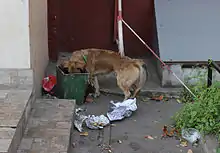Street dog
Street dogs, known in scientific literature as free-ranging urban dogs,[1][2] are unconfined dogs that live in cities. They live virtually everywhere where cities exist and the local human population allows, especially in the developing world and the former USSR. Street dogs may be stray dogs, pets which have strayed from or are abandoned by their owners, or may be feral animals that have never been owned.[3] Street dogs may be stray purebreds, true mixed-breed dogs, or unbred landraces such as the Indian pariah dog. Street dog overpopulation can cause problems for the societies in which they live, so campaigns to spay and neuter them are sometimes implemented. They tend to differ from rural free-ranging dogs in their skill sets, socialization, and ecological effects.

Problems caused by street dogs
Bites
Like wolves, to survive, street dogs need to avoid conflict with humans. However, dog bites and dog attacks can occur when dogs are trying to mate or fighting among themselves, and pedestrians and other humans in the vicinity may be bitten by fighting. Rabies is a major problem in some countries. India has more than 30 million stray dogs with more than 20,000 people dying of rabies every year.[4]
Quality of life
Barking and howling and dog fights over mating among dogs can be disturbing to people,[5] and the smell of dog urine which is a product of territory marking may become pungent among unspayed or neutered dogs, not to mention the presence of feces (toxocariasis).
Skills and adaptations
Dogs are known to be a highly adaptive and intelligent species. To survive in modern cities, street dogs must be able to navigate traffic.
Some of the stray dogs in Bucharest are seen crossing the large streets at pedestrian crosswalks. The dogs have probably noticed that when humans cross streets at such markings, cars tend to stop.[6] The dogs have accustomed themselves to the flow of pedestrian and automobile traffic; they sit patiently with the people at the curb when they are stopped for a red light, and then cross with them as if a daily routine.[7]
In cities in Russia and several other countries, street dogs are said to have been observed to use subway and bus services.[8][9]
Free-ranging urban dogs by country
Australia
In Australia, comprehensive data are not available, although Death Row Pets estimated 250,000 healthy but unwanted dogs and cats are killed in Australian municipal pounds each year. In recent years, many Australian animal rescue organisations such as Give Our Strays A Chance have stepped forward to rescue as many animals from death row.
Afghanistan
Nowzad is an organisation in Afghanistan that works to rescue stray dogs in that country.[10] A group of stray dogs became famous in Afghanistan after confronting a suicide bomber, preventing fifty American soldiers from being killed.[11] However, one of the surviving dogs, Target, was mistakenly euthanized when she was brought to the United States.[12]
India
Due to the collapse of vulture populations in India, which formerly consumed large quantities of dead animal carcasses and terminated certain pathogens from the food chain,[13] India's urban street dog populations have exploded and become a health hazard.[14] Mumbai, for example, has over 12 million human residents, over half of whom are slum-dwellers. At least five hundred tons of garbage remain uncollected daily. Therefore, conditions are perfect for supporting a particularly large population of stray dogs.[15]
In 2001, a law passed in India making the killing of stray dogs illegal has exacerbated the problems related to street dogs, increasing the street dog population and causing rabies cases in humans to rise.[15][16] India has the highest number of human rabies deaths in the world (estimated at 20,000 per year).[15] "Catch and kill" programmes have been a traditional solution to overwhelming dog populations, but there are also programmes such as the Animal Birth Control-Anti-Rabies (ABC-AR) programme started by Blue Cross of India based in Chennai, India.[17] Several dog shelters throughout India emphasize the rescue of stray dogs, especially in South and North eastern parts of India.
Pakistan
In Pakistan, several dog breeds exist including the Gaddi Kutta, Indian pariah dog, Bully Kutta, among others.[18] In the city of Lahore, the Public Health Department launched a campaign to kill 5,000 stray dogs.[19] In 2009, 27,576 dogs were killed within the city of Lahore; in 2005, this number was 34,942.[20] In 2012, after 900 dogs were killed in the city of Multan, the Animal Safety Organisation in Pakistan sent a letter to Chief Minister (CM) Shahbaz Sharif recommending that "stray dogs be vaccinated rather than killed."[21]
Sri Lanka
In Sri Lanka, there is a No-Kill Policy for street dogs, hence neutering and vaccinating are encouraged. Despite the proposal for an updated Animal Welfare Act, century-old law against animal cruelty still exist, so they are subjected to cruelty in various forms.
Italy
Around 80% of abandoned dogs die early due to lack of survival skills.[22]
Romania

In Romania, free-ranging urban dogs (called in Romanian câini maidanezi, literally "wasteland dogs", câini comunitari "community dogs", etc.) have been a huge problem in recent decades, especially in larger cities, with many people being bitten by dogs. The problem originates primarily in the systematization programme that took place in Communist Romania in the 1970s and 1980s under Nicolae Ceaușescu, who enacted a mass programme of demolition and reconstruction of existing villages, towns, and cities, in whole or in part, in order to build standardized blocks of flats (blocuri). The dogs from the yards of the demolished houses were abandoned on the streets, and reproduced, multiplying their numbers throughout the years. Estimations for Bucharest vary widely, but the number of stray dogs has been reduced drastically in 2014,[23] after the death of a 4-year-old child in 2013 who was attacked by a dog. The Bucharest City Hall stated that over 51,200 stray dogs were captured from October 2013 to January 2015, with more than half being euthanized, about 23,000 being adopted, and 2,000 still residing in the municipality's shelters.[24]
Russia

Stray dogs are very common in Russia. They are found both in the countryside and in urban areas. In Russia, street dogs are accepted by the common people and are even fed by the local population, including in the capital city of Moscow.[25] However, capturing of stray dogs by doghunters' vans and being culled has been documented since around 1900. The number of street dogs in Moscow is estimated to be up to 50,000 animals. Their sad lot was dramatized by Anton Chekhov in the famous short story Kashtanka, by Mikhail Bulgakov in the novella Heart of a Dog, and by Gavriil Troyepolsky in the novel White Bim Black Ear. When the number of street dogs massively increased in the 1990s and in the beginning of the new millennium it came to many attacks on human, the dogs were captured and killed. In recent years the attitude and strategy towards street dogs has changed. The dogs are caught, sterilized and it is ensured that the dogs have enough to eat. The dogs keep the city free of food leftovers and rats. Since 2002 in Moscow there exists a monument dedicated to the stray dog called Malchik (Eng: "Little boy"). Stray dogs in Moscow have adapted their behavior to traffic and the life of Moscow. The dogs even ride the metro and understand the rules of traffic lights and are often called Moscow's metro dogs.[26][27][28][29][30]
Serbia
Free-ranging dogs are a serious problem of the Serbian cities and rural areas.[31] The total number of free-ranging dogs in Serbia is estimated at several tens of thousands,[32] of which the largest groups can be found in Belgrade (more than 17,000), Novi Sad (about 10,000), Niš (between 7,000 and 10,000), Subotica (about 8,000) and Kragujevac (about 5,000).[33]
United States
Each year, approximately 2.7 million dogs and cats are euthanized because shelters are too full and there are not enough adoptive homes. In 2016, between 592,255 and 866,366 street dogs were euthanized in the US.[34]
Puerto Rico
In Puerto Rico, street dogs (and cats) are known as satos.[35] In the late 1990s it was estimated there were 50,000 street dogs in the U.S. territory.[36] By 2018 there were around 300,000 stray dogs in Puerto Rico.[37] Programs to address the problem have been launched by the Humane Society of Puerto Rico and others. In 2018, a non-profit organization called Sato Project launched its first "spayathon", a large-scale project to spay and neuter satos of Puerto Rico. Other initiatives include having mainland U.S. residents adopt the island dogs.[38]
Philippines
Locally known as Askals, street dogs in the Philippines, while sometimes exhibiting mixing with breed dogs from elsewhere, are generally native unbred mongrel dogs.
Thailand
See also
References
| Wikimedia Commons has media related to Feral dogs. |
- Daniels, T.J. (July 1983). "The social organization of free-rangingurbandogs. I. Non-estrous social behavior". Applied Animal Ethology. 10 (4): 341–363. doi:10.1016/0304-3762(83)90184-0.
- Pal, Sunil Kumar (2001). "Population ecology of free-ranging urban dogs in West Bengal, India". Acta Theriologica. 46 (1): 69–78. doi:10.1007/BF03192418. ISSN 0001-7051. S2CID 26159565.
A population of urban free-ranging dogsCanis familiaris Linnaeus, 1758 was studied in Katwa, West Bengal, India. The analysis of changes in the density of the dog population over a period of 4 years revealed a considerable stability of this population. Mean (±SD)2 seasonal population density was
- Miklósi, Adam (4 December 2008). Dog Behaviour, Evolution, and Cognition. Oxford University Press. p. 205. ISBN 9780191580130.
Some dogs lead a relatively free life despite being socialized to some extent. These dogs have or can establish a social relation with human(s) and may be fed and sheltered regularly (stray dogs, village dogs).
- Biswas, Soutik (6 May 2016). "Do India's stray dogs kill more people than terror attacks?". BBC News.
- AKC Staff. "How to Stop Nuisance Dog Barking". American Kennel Club.
- "Stray Dogs Offered as Pedestrian Role Models : Discovery News". News.discovery.com. 23 January 2013. Retrieved 16 November 2013.
- "Romanian police recruit stray dogs for road safety lessons". The Raw Story. 23 January 2013. Retrieved 16 November 2013.
- "The Subway-Riding Dogs of Moscow - Oddity Central - Collecting Oddities". Oddity Central. 29 August 2011. Retrieved 15 May 2015.
- "Smartest Dogs: Moscow Stray Dogs - English Russia". englishrussia.com. 7 April 2009. Retrieved 15 May 2015.
- Itasaka, Kiko (5 October 2013). "Afghan shelter reunites dogs and cats of war with soldiers back home". NBC. Retrieved 2 October 2014.
"We don't turn any animal in need away," said Hastie, who runs the Nowzad Animal Shelter in Kabul. Nowzad is named after the small town in Helmand where the first dog was adopted in 2007. In six years, Nowzad has taken in thousands of animals of war, many of which were adopted by soldiers serving all over Afghanistan. The charity has organized the transport of over 400 dogs and cats to be reunited with former soldiers in the United States and the United Kingdom.
- Lacey, Marc (18 November 2010). "Afghan Hero Dog Is Euthanized by Mistake in U.S." The New York Times. Retrieved 2 October 2014.
When a suicide bomber entered an American military barracks in Afghanistan in February, it was not American soldiers but Afghan stray dogs that confronted him. Target and two other dogs snarled, barked and snapped at the man, who detonated his bomb at the entrance to the facility but did not kill anyone.
- Caulfied, Philip (16 November 2010). "Target, 'war hero dog' who saved 50 soldiers in Afghanistan, mistakenly put to death in AZ shelter -". Daily News. Retrieved 3 October 2014.
A heroic dog who saved the lives of dozens of soldiers in Afghanistan and melted hearts on "Oprah" was accidentally euthanized at an Arizona animal shelter on Monday. The dog, Target, was a stray in Afghanistan who befriended soldiers and was hailed as a hero after she chased away a suicide bomber who tried to blow up a military base last February. The suicide bomber had sneaked onto the base and was headed toward a barracks that housed nearly 50 soldiers when Target and two other dogs attacked him, Target's owner, Sgt. Terry Young told Arizona's KOLD-TV.
- Geggel, Laura (25 November 2014). "How Vultures Can Eat Rotting Flesh Without Getting Sick". livescience.com.
- Markandyaa, Anil; Taylor, Tim; Longo, Alberto; Murtyd, M.N.; Murtyd, S. and Dhavalad, K.; 'Counting the cost of vulture decline—An appraisal of the human health and other benefits of vultures in India'; Ecological Economics 67 (2), 15 September 2008, pp 194–204
- Harris, Gardiner (6 August 2012). "Where Streets Are Thronged With Strays Baring Fangs". The New York Times. Retrieved 3 October 2014.
A 2001 law forbade the killing of dogs, and the stray population has increased so much that officials across the country have expressed alarm.
- Macrae, Penelope (9 August 2012). "India stray dogs to form security squad". Yahoo!. Retrieved 3 October 2014.
A 2001 law forbids killing roaming dogs and the stray population has since soared, feeding off India's infamous mountains of street garbage as well as on kitchen scraps given to them by residents.
- Rajan, Radha (10 June 2013). "A voice for Chennai's street dogs". Archived from the original on 15 July 2013 – via www.thehindu.com.
- Pathak, Arun (1995). Handicrafts in the Indus Valley Civilization. Janaki Prakashan. ISBN 978-8185078878.
- "City launches drive against stray dogs". The Express Tribune. The New York Times. 4 May 2011. Retrieved 2 October 2014.
The city government's Public Health Department has launched a campaign to kill nearly 5,000 dogs in the district. Officials say that the risk to public health from stray dogs increases in the summer.
- "City launches drive against stray dogs". The Express Tribune. The New York Times. 4 May 2011. Retrieved 2 October 2014.
Last year, 27,576 stray dogs were killed in Lahore. This century, the highest number of dogs killed in one year in Lahore was 34,942 in 2005.
- Malik, Sonia (21 November 2012). "850 stray dogs shot dead in a week". The Express Tribune. Retrieved 2 October 2014.
Muhammad Usman, president of the Animal Safety Organisation Pakistan, said he had written a letter to CM Shahbaz Sharif recommending that stray dogs be vaccinated rather than killed. He said he had recommended that shelter homes be built for stray animals. Usman said the government had already killed nearly 900 dogs in Multan over the last two weeks. "An injection can kill rabies germs in a dog... after that a dog attack is no longer lethal." he said.
- "NASCE MORANDO PER IL SOCIALE". pettrend.it. Retrieved 15 May 2015.
- "Bucureştiul a rămas fără maidanezi. ASPA: Mai sunt în jur de 1.500 de câini pe străzi. Am adunat 55.000". adevarul.ro. Retrieved 20 January 2019.
- Insider, Romania; Media, City Compass. "What happened to the 51,000 stray dogs captured in Bucharest? - Romania Insider". Retrieved 20 January 2019.
- "Hund adoptieren Tierschutz Russland e.V. über Russland". www.hund-adoptieren.de. Retrieved 7 December 2020.
- McGrane, Sally (8 July 2013). "Moscow's Metro Dogs". The New Yorker (Serial). ISSN 0028-792X. Retrieved 16 September 2019.
- "In Moskau leben drei Millionen Hunde". Schwäbisches Tagblatt (in German). Retrieved 16 September 2019.
- Boyd, Jacqueline. "How did Moscow's stray dogs learn to navigate the metro?". The Conversation. Retrieved 16 September 2019.
- "Moskaus Straßenhunde fahren Metro". Deutschlandfunk Nova (in German). Retrieved 16 September 2019.
- "Ein Rudel Straßenhunde springt in die Bahn. Was sie dann tun, ist nicht zu fassen". Tierfreund (in German). Retrieved 16 September 2019.
- "Otrovano 5 pasa u Nišu : Hronika : Južne vesti". Juznevesti.com. Retrieved 16 November 2013.
- "Napadi pasa lutalica". e-novine.com. 30 April 2011. Retrieved 23 August 2012.
- https://zoipet.com/cac-giong-cho-canh. Retrieved 26 February 2013. Missing or empty
|title=(help) zoipet.com - Rowan, Andrew; Kartal, Tamara (28 April 2018). "Dog Population & Dog Sheltering Trends in the United States of America". Animals. 8 (5): 68. doi:10.3390/ani8050068. PMC 5981279. PMID 29710771.
- "sato, sata | Diccionario de la lengua española". «Diccionario de la lengua española» - Edición del Tricentenario.
- Navarro, Mireya (6 January 1998). "Puerto Rico Tackles Issue of Stray Dogs' Suffering". The New York Times. Retrieved 8 July 2017.
- "Contabilizan a los animales realengos [Census taken of stray animals]". El Nuevo Dia (in Spanish). 7 April 2018.
- "First-ever 'Spayathon' Kicks Off in Puerto Rico". Veterinarian's Money Digest.
Further reading
- Beck, Alan M .1973. The ecology of stray dogs: A study of free-ranging urban animals. West Lafayette, Indiana: Purdue University Press e-books.
- Ecollage. 2002. Dog Population Management & Canine Rabies Control. India's Official Dog Control Program in an international context. Pune. pp. 1–9
- Irvine, Leslie. 2003. "The Problem of Unwanted Pets: A Case Study in How Institutions "Think" about Clients' Needs" in Social Problems. Vol. 50, No. 4, pp. 550–566
- Kato Masahiko, Hideki Yamamoto, Yoshihide Inukai and Shohei Kira. 2203. "Survey of the Stray Dog Population and the Health Education Program on the Prevention of Dog Bites and Dog-Acquired Infections: A Comparative Study in Nepal and Okayama Prefecture, Japan" in Acta Med. Okayama, Vol. 57. No. 5, pp. 261–266


